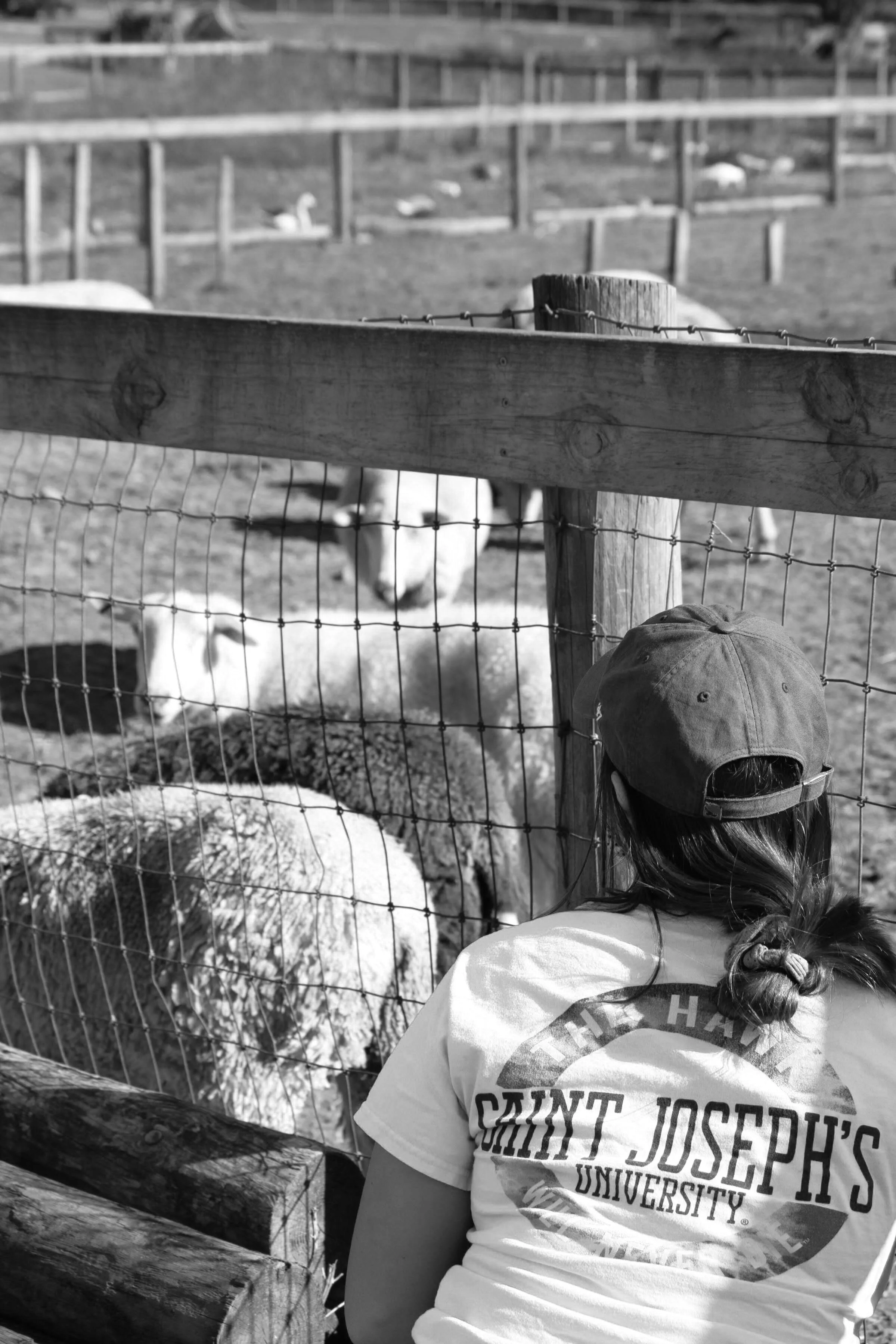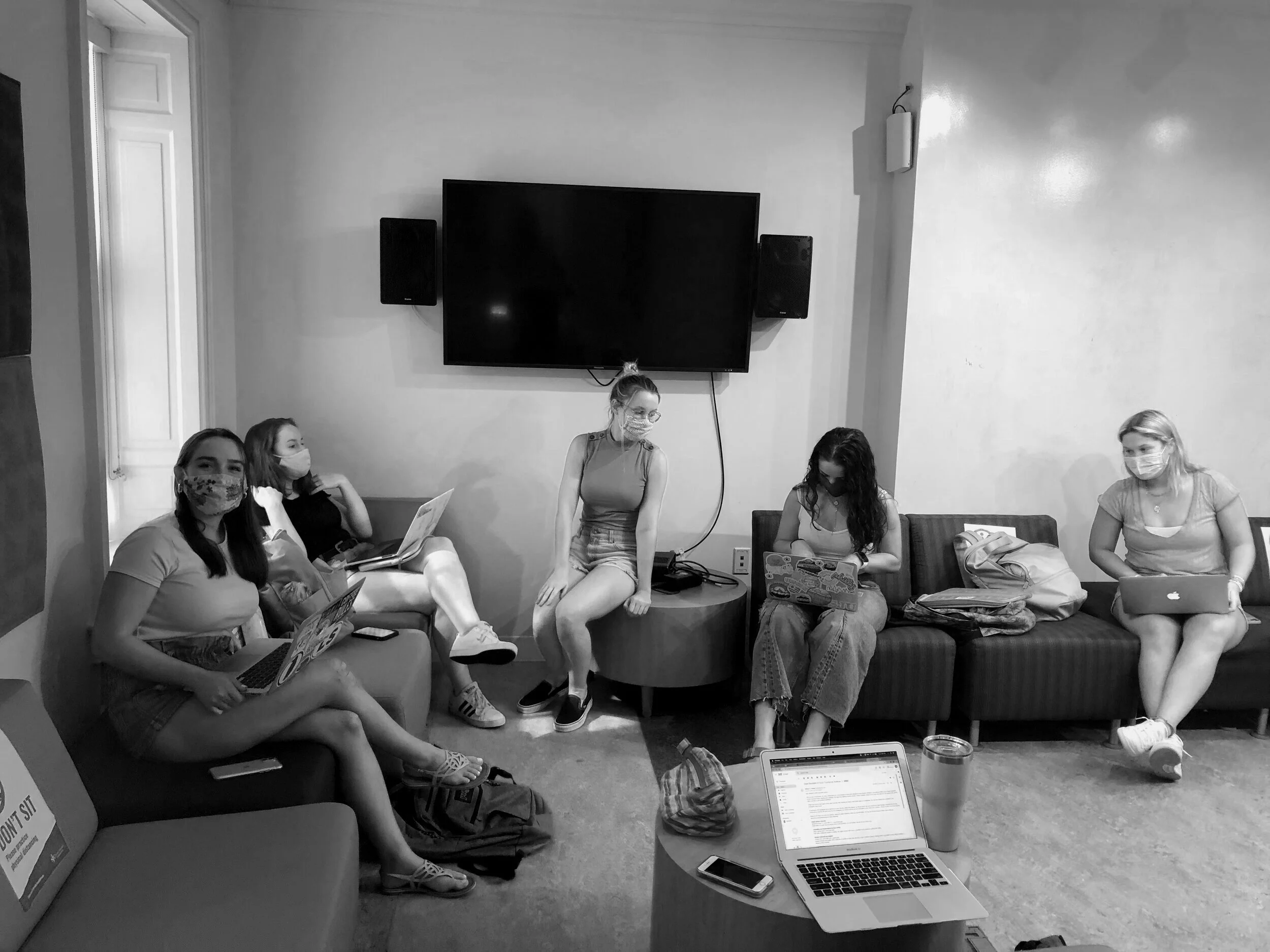Chenoa Manor
Comparative Media Analysis
The Community Partner
Chenoa Manor is an animal sanctuary and a learning center located in Chester County, PA. Chenoa Manor takes in animals who were previously abused by factory farming, cruelty, or hoarding situations; others were subjected to laboratory experiments or simply abandoned in the wild and left to fend for themselves. Chenoa Manor is a volunteer run and has no paid staff, which relies on the public’s contributions to support the costs to upkeep the farm and animals. Chenoa Manor serves the animals to make sure that they are not exploited. There are also events on the farm, like art and photography classes.
Who was involved in the project and what were the roles?
Our group consisted of Emma Wright, Nenagh Sheehan, Anna Kalafatis, and Sam Jenkins. Our fellow was Lexi Mignogna. Emma was the content creator, Nenagh was the notetaker and analyst, Anna was the facilitator, and Sam was the documentarian and scheduler. Lexi was the main point of contact between the group and Chenoa Manor.
When and where did the project take place?
The project took place at the Chenoa Manor farm, and we were able to visit the farm once and meet Megan Smock, a volunteer executive who showed us around the farm. The social media campaign for donations took place on Facebook and Instagram because those are Chenoa Manor’s leading platforms where they post content. The fundraising campaign started on November 1st and ended on Giving Tuesday (December 1st) so it was a month-long and thought it was a good idea to end it on Giving Tuesday so people would be more inclined to donate. Giving Tuesday is the Tuesday after Thanksgiving which encourages people to donate during the holiday season. Our group also took our own photographs at Chenoa Manor, where we used them when taking over the Chenoa Manor Instagram.
What was the group’s role in the project?
The group’s role in the project was to help Chenoa Manor raise funds for repairs and animal feed through social media, while simultaneously revamping Chenoa Manor’s social media across multiple platforms. The group created Venmo boards in Canva to be posted on Chenoa Manor’s social media accounts, showing animal graphics correlating to a certain amount of money and users can donate, through Venmo, the amount shown on one of the animals. The group also created a thermometer graphic which was posted on Chenoa Manor’s social media and frequently updated to track the funds raised to support Chenoa Manor. We decided to use this graphic as a tracker to show users and donors where their money is going and have a clear visual to show progress of fundraising efforts. The group also helped design t-shirts which are also being sold to help raise funds.
In regards to posting on Chenoa Manor’s social media, we have been granted access to Chenoa Manor’s Planoly account and have been scheduling posts to go live on social media. These posts are meant to increase engagement with the Chenoa Manor’s followers and publicize the group’s fundraising efforts.
What was your relationship to the community partner and how was that relationship developed over time?
The relationship between Chenoa Manor and the group was slow to form due to the ongoing pandemic. The group still managed to build a relationship through emails, Zoom meetings, and lucky enough to visit it. The group’s first meeting with Chenoa Manor occurred over a Zoom call with Megan Smock, an executive volunteer on Chenoa Manor. This meeting went well, and items such as branding and fundraising ideas were discussed. Smock was engaged and happy to integrate the group into Chenoa Manor’s operations.
The group also met with Christiane Moore, the social media director for Chenoa Manor. Christiane also welcomed the group into the operations with open arms, granting us access to Chenoa Manor’s Planoly account, which is the application that social media posts are stored in until it is time for the post to be posted. Moore also gave the group access to a Google folder full of photographs she took of the animals at Chenoa Manor to help us with content as we took over Chenoa’s social media.
With both contacts the group has had with Chenoa Manor (Smock and Moore) being very open and inviting to the group, it was easy to form a connection and build trust. This mutual respect and effective collaboration has led us to the successful social media posts and fundraising events that have been beneficial to Chenoa Manor.
Who participated in the design/research process?
We all contributed to the semester-long project, which we ran to gain donations for Chenoa Manor. For example, when we had to upload a scheduled post to Planoly for the Chenoa Manor Instagram and each week, someone from our group had a different week that they would take over. We would upload three posts for one week, which would end up on Chenoa Manor’s Instagram page. The posts consisted of bringing awareness to the T-shirts, the GoFundMe, and the Venmo. We also posted Venmo boards, which was a graphic consisting of different animals, that had various amounts of dollars next to them that people could donate. Once someone donated a certain amount we would tag them on whatever price they gave. We posted those to our Instagram stories, where you can post photos and videos that are only up for 24 hours. Through that we got our followers to donate to raise money for the bales of hay Chenoa Manor needed. Emma made a graphic for us to post on our Facebook explaining to our friends and family what we need for donations, the Facebook posts had a link to their GoFundMe, and we also provided people with our personal Venmo’s.
What was the collaboration and co-creation process?
The collaboration and co-creation process consisted of a few group meetings with Christiane and Megan, individual work based on those meetings, and individual research that our group conducted and then shared with one another. We met with Christiane and Megan in the very beginning of the semester via Zoom. This is where we learned about Chenoa Manor’s Buddhist ideals, their reasons for taking certain animals in, the stories and backgrounds of volunteers, the current needs of Chenoa Manor, and the ins and outs of how Chenoa Manor is run. This inside information was essential in forming ideas for fundraising and to get a general sense of Chenoa Manor as an organization. Based on these meetings, we got an idea of what Chenoa Manor needed from us and how to move forward, and we then started the process of individual work. Each member worked individually on Venmo board designs, t-shirt designs, Facebook and Instagram designs and posts, and paragraphs to send to family and friends asking for donations. We then sent these to Christiane and Megan, who collaborated with us to refine and edit. Finally, we did individual research about Chenoa Manor and their social media platforms throughout the whole project, sharing information as we found it. Through our individual research, we were able to figure out their style, color scheme, tone, and other important factors that we needed in order to successfully use their social media and reach their target audience.
How was the research/design process determined?
Our group naturally split up between designing and researching for different parts of the project. For example, while some of us leaned more towards the graphic design aspect of fundraising, others leaned towards the writing part. Instead of assigning strict roles, we chose what we wanted to do as we went. This turned out to be a very effective process, as it made us feel less like we were doing work that had to be done, and instead doing little projects that fit into the type of work we hope to do after college. It also helped to have Chenoa Manor’s brand book which gave us a general understanding of what their social media, newsletter, emails, etc. look and sound like.
What were some of the challenges of the research/design process?
Our group’s challenges were not having our meetings in person due to COVID, but we could visit the farm with safety precautions, which helped us get some photos of the farm to post on their social media. We had to email and ask for them to upload the post that was uploaded manually. The first week of our campaign, we raised about 600 dollars because we made it service hours for Alpha Gamma Delta, meaning if they donated, they would get service hour points; because of this, we saw an influx in the donation campaign. The next week we plateaued after each group member already asked their friends and family to donate, but we brought funds back up by selling T-shirts. We also ran into a problem when we uploaded an automatic post to the Planoly of the goats they have on the farm, which was then uploaded to their Instagram but had to be deleted. Moore asked us to delete the goats’ pictures because there were issues regarding people surrendering the goats.
Results
What were the project outcomes or the project impact?
So far, we’ve raised around $1,500 for Chenoa Manor based solely on our Venmo board and Facebook campaign. 9 bales of hay have been donated, but our goal is to have 100 within the next 2 weeks. Though we have no way of getting exact measurements for this next part, we do know that we have made Chenoa Manor known to a group of people that wouldn’t have come across it otherwise- this group is college-aged students. As these students graduate and go into the world, hopefully they will remember Chenoa Manor and donate in the future or even volunteer.
Who benefitted from the project?
The volunteers and, more importantly, the animals were benefited by the project. Throughout the campaign, we were able to raise money for food for the animals for winter. Since the food, specifically the hay, is so expensive, our fundraising helped to provide the animals with over thirty bales of hay for the animals.
Who was harmed or potentially harmed from it?
We were very fortunate that no one was specifically harmed from our project. Chenoa Manor is an amazing organization that rescues animals from abusive or harmful situations and gives them the best home possible. They also give back to the community through their programs that connect people with animals and teach them about art and nature. Because of how giving Chenoa Manor is, helping to raise money for them did not harm anyone.
How does the project live on?
The sustainability of our project comes through the new examples and ideas we learned through our research. We were able to pass these ideas along to Chenoa Manor in order to help them run their social media more effectively. If they follow our examples and advice, they will be able to communicate better with their followers by providing a more intimate look into daily life at the farm, and by showcasing more graphics and more information about upcoming fundraisers. In this way, Chenoa Manor will raise more money in the future, and the results of our project can live on year after year.




